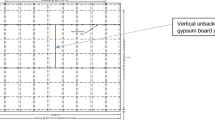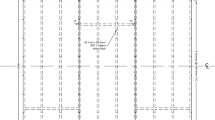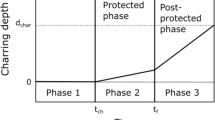Abstract
This paper discusses the factors that affect the fire resistance performance of lightweight wood frame unrestrained floor assemblies protected with Type X gypsum board ceiling finishes. Twenty-two fire resistance experiments were conducted on full-scale load-bearing wood joist floor assemblies using the ULC standard fire exposure time–temperature curve that is similar to ASTM E119 standard. Parameters investigated in this study include the effects of gypsum board screws spacing from board edges, insulation installation, insulation type, joist spacing for assemblies with gypsum board attached to resilient channels, joist depth, resilient channel installation, resilient channel spacing, sub-floor topping, number of sub-floor layers, and load magnitude. The impact of these parameters on the fire resistance of wood joist frame floor assemblies is discussed. The fire resistance of wood frame floors appears essentially to be governed by the gypsum board screw spacing from the board edges and the type of insulation in assemblies with one layer of gypsum board and by the resilient channel spacing and the gypsum board screw spacing from the board edges in assemblies with two layers of gypsum board. The effects of other parameters in assemblies with two layers of gypsum board such as the joist spacing where the gypsum boards are attached to resilient channels, installation of resilient channels, insulation installation, insulation type, adding gyp-crete topping above the sub-floor and number of sub-floor layers on fire resistance are relatively insignificant.




















































Similar content being viewed by others
References
National Building Code of Canada (Part 9) (1995) National Research Council of Canada, Ottawa, ON
Sultan MA, Seguin YP, Leroux P (1998) Results of fire resistance tests on full-scale floor assemblies, Internal Report No. 764. Institute for Research in Construction, National Research Council of Canada, Ottawa, ON
Sultan MA, Latour JC, Leroux P, Monette RC, Seguin YP, Henrie J (2005) Results of fire resistance tests on full-scale floor assemblies – phase II. Research report 184. Institute for Research in Construction, National Research Council Canada, Ottawa, Ontario
CAN/ULC-S101-M89 (1989) Standard methods of fire endurance tests of building construction and materials. Underwriters’ Laboratories of Canada, Scarborough, ON
ASTM E119-88 (1988) Standard test method for fire tests of building construction and materials. ASTM, West Conshohocken, PA
National Building Code of Canada (Part 9) (2005) National Research Council of Canada, Ottawa, ON
Benichou N (2004) Structural response modelling of wood joist floor assemblies exposed to fires. In: Proceedings of the 10th international fire science & engineering conference (Interflam2004), Edinburgh, Scotland. Interscience Communications Ltd., West Yard House, Guildford Grove, Greenwich, London SE10 8JT, England
Richardson L (2004) Failure of floor assemblies constructed with timer joists, wood trusses or I-joists during fire resistance tests. In: Proceedings of the 10th international fire science & engineering conference (Interflam2004), Edinburgh, Scotland. Interscience Communications Ltd., West Yard House, Guildford Grove, Greenwich, London SE10 8JT, England
CAN/CSA-A82.31-M91 (1991) Gypsum board application. Canadian Standards Association, Rexdale, ON
CSA A101-M83 (1983) Thermal insulation. Canadian Standards Association, Rexdale, Ontario
CAN/ULC-S702-M97 (1997) Standard for mineral fibre thermal insulation for buildings. Underwriters’ Laboratories of Canada, Scarborough, Ontario
CAN/CGSB 51.60-M90 (1990) Cellulose fibre loose fill thermal insulation. Canadian Standards Board, Ottawa, Ontario
CAN/CSA-82.27-M91 (1991) Gypsum board. Canadian Standards Association, Etobicoke, Ontario, Canada
ASTM C36-97 (1997) Standard specification for gypsum wallboard. American Society for Testing and Materials, West Conshohocken, PA
Shorter GW, Harmathy TZ (1960) Fire research furnaces at the national research council, NRC 5732. National Research Council of Canada, Ottawa, Ontario
Acknowledgements
The National Research Council of Canada wishes to acknowledge the technical and financial contributions of the partners in this Joint Research Project. The partners include: Boise Cascade, Canada Mortgage and Housing Corporation, Canadian Home Builder Association, Canadian Portland Cement Association, Canadian Sheet Steel Building Institute, Canadian Steel Construction Council, Canadian Wood Council, Cellulose Insulation Manufacturers’ Association of Canada, Forintek Canada Corporation, US Gypsum Association, Gypsum Manufacturers’ of Canada, Louisiana-Pacific Corporation, Nascor Inc., Ontario Home Warranty Program, Ontario Ministry of Municipal Affairs and Housing, Truss Plate Institute, Truss Plate Institute of Canada, US Cellulose Manufacturers Association, Johns Manville International, Owens-Corning Canada, Willamette Industries, Roxul Inc., Trus Joist MacMillan. Also, the author wishes to thank Jocelyn Henrie, John Latour, Patrice Leroux, Rock Monette and Richard Rombough for construction the assemblies and conducting the experiments.
Author information
Authors and Affiliations
Corresponding author
Rights and permissions
About this article
Cite this article
Sultan, M.A. Fire Resistance of Wood Joist Floor Assemblies. Fire Technol 44, 383–417 (2008). https://doi.org/10.1007/s10694-007-0038-0
Received:
Accepted:
Published:
Issue Date:
DOI: https://doi.org/10.1007/s10694-007-0038-0




